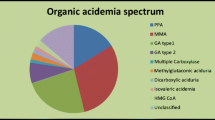Summary
North Carolina (NC) was the first US state to initiate universal tandem mass spectrometry (MS/MS) newborn screening. This began as a statewide pilot project in 1997 to determine the incidence and feasibility of screening for fatty acid oxidation, organic acid and selected amino acid disorders. The MS/MS analyses were done by a commercial laboratory and all follow-up and confirmatory testing was performed through the NC Newborn Screening (NBS) Program. In April 1999, the NC NBS Laboratory began the MS/MS analyses in-house. Between 28 July 1997 and 28 July 2005, 944 078 infants were screened and 219 diagnoses were confirmed on newborns with elevated screening results, for an overall incidence of 1:4300. Ninety-nine infants were identified with fatty acid oxidation disorders, 58 with organic acidaemias and 62 with aminoacidopathies. Medium-chain acyl-CoA dehydrogenase deficiency, 3-methylcrotonyl-CoA carboxylase deficiency and disorders of phenylalanine metabolism were the most common disorders detected. Identification of affected infants has allowed retrospective testing of other family members, resulting in an additional 16 diagnoses. Seven neonates died from complications of their metabolic disorders/prematurity despite timely MS/MS screening. In addition, there were six infants who were not identified by elevated NBS results but who presented with symptoms later in infancy. The NC MS/MS NBS Program uses a two-tier system, categorizing results as either ‘borderline’ or ‘diagnostic’ elevated, for both the cutoffs and follow-up protocol. Infants with an initial borderline result had only a repeat screen. Infants with a diagnostic or two borderline results were referred for confirmatory testing. The positive predictive value of the NC MS/MS NBS for those infants requiring confirmatory testing was 53% for 2003 and 2004. The success of the NC MS/MS NBS Program in identifying infants with metabolic disorders was dependent on a comprehensive follow-up protocol integrating the public health laboratory and the academic metabolic centres.
Similar content being viewed by others
References
Chace DH, Kalas T, Naylor EW (2003) Use of tandem mass spectrometry for multianalyte screening on dried blood specimens from newborns. Clin Chem 49: 1797–1817.
Hill JB, Summer GK, Pender MW, Roszel O (1965) An automated procedure for blood phenylalanine. Clin Chem 11: 541–546.
Hoffmann GF, von Kries R, Klose D, et al (2004) Frequencies of inherited organic acidurias and disorders of mitochondrial fatty acid transport and oxidation in Germany. Eur J Pediatr 163: 76–80.
Koeberl DD, Millington DS, Smith WE, et al (2003a) Evaluation of 3-methylcrotonyl CoA carboxylase deficiency detected by tandem mass spectrometry screening. J Inherit Metab Dis 26: 25–35.
Koeberl DD, Young SP, Gregerson N, et al (2003b) Rare disorders of metabolism with elevated butyryl- and isobutyrylcarnitine detected by tandem mass spectrometry screening. Pediatr Res 54: 219–223.
Kwon C, Farrell PM (2000) The magnitude and challenge of false positive newborn screening test results. Arch Pediatr Adolesc Med 154: 714–718.
Millington DS (2002) Newborn screening for metabolic diseases: the second generation of newborn screening techniques. Am Sci 90: 40–48.
Millington DS, Kodo N, Norwood DL, Roe CR (1990) Tandem mass spectrometry: a new method for acylcarnitine profiling with potential for neonatal screening for inborn errors of metabolism. J Inherit Metab Dis 13: 321–324.
O’Reilly L, Bross P, Corydon TJ, et al (2004) The Y42H mutation in medium-chain acyl-CoA dehydrogenase, which is prevalent in babies identified by MS/MS-based newborn screening, is temperature sensitive. Eur J Biochem 271: 4053–4063.
Schulze A, Lindner M, Kohlmüller K, Olgemöller K, Mayatepek E Hoffman F (2003) Expanded newborn screening for inborn errors of metabolism by electrospray ionization-tandem mass spectrometry: results, outcome, and implications. Pediatrics 111: 1399–1406.
Smith WE, Millington DS, Koeberl DD, Lesser PS (2001) Glutaric acidaemia, type I, missed by newborn screening in an infant with dystonia following promethazine administration. Pediatrics 5: 1184–1187.
Van Hove JL, Zhang W, Kahler SG, et al (1993) Medium-chain acyl-CpA dehydrogenase (MCAD) deficiency: diagnosis by acylcarnitine analysis in blood. Am J Hum Genet 52: 958–966.
Wilcken B, Wiley V, Hammond J, Carpenter K (2003) Screening newborns for inborn errors of metabolism by tandem mass spectrometry. N Engl J Med 23: 2304–2312.
Zytkovicz TH, Fitsgerald EF, Marsden D, et al (2001) Tandem mass spectrometric analysis for amino, organic and fatty acid disorders in newborn dried blood spots: a two-year summary from the New England Newborn Screening Program. Clin Chem 47: 1945–1955.
Author information
Authors and Affiliations
Corresponding author
Additional information
Communicating editor: Rodney Pollitt
Competing interests: None declared
Rights and permissions
About this article
Cite this article
Frazier, D.M., Millington, D.S., McCandless, S.E. et al. The tandem mass spectrometry newborn screening experience in North Carolina: 1997–2005. J Inherit Metab Dis 29, 76–85 (2006). https://doi.org/10.1007/s10545-006-0228-9
Received:
Accepted:
Issue Date:
DOI: https://doi.org/10.1007/s10545-006-0228-9




